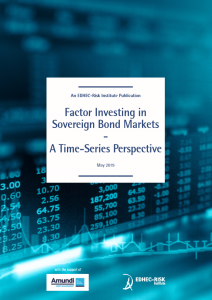

Factor Investing in Sovereign Bond Markets – A Time-Series Perspective
This paper has been produced as part of the "ETF, Indexing and Smart Beta Investment Strategies" Research Chair at EDHEC-Risk Institute, in partnership with Amundi. Following up on more than a deca ...
Author(s):
Summary:
This paper has been produced as part of the "ETF, Indexing and Smart Beta Investment Strategies" Research Chair at EDHEC-Risk Institute, in partnership with Amundi. Following up on more than a decade-long research effort in the area of factor investing in equity markets, we have felt a timely need amongst asset owners and asset managers to gain a better understanding of the theoretical and practical challenges involved in harvesting risk premia in fixed-income markets.
This paper “Factor Investing in Sovereign Bond Markets – A Time-Series Perspective” provides a detailed analysis of the theoretical, statistical and practical challenges related to factor investing in sovereign bond markets, with a focus on factors such as the "level" or "slope" of the yield curve that explain, for any maturity, a large fraction of differences over time in bond returns.
Using a comprehensive database of individual bond returns in the US over the 1973-2018 sample period, we find that a conditional version of a carry strategy based upon a time-varying exposure to the level factor can generate up to 200 basis points of excess performance.
We also find, using yield curve data, that a conditional version of a flattener strategy based upon a time-varying exposure to the level factor can generate economically-significant additional performance, even though such excess performance is limited in implementation by the presence of leverage constraints.
Overall, our results suggest that even in a single-issuer universe with highly correlated bond returns, and after accounting for transaction costs, factor investing can allow for an efficient harvesting of economically-significant time-series risk premia.
Register to download PDF
Register/Log in| Type : | EDHEC Publication |
|---|---|
| Date : | 16/05/2019 |

